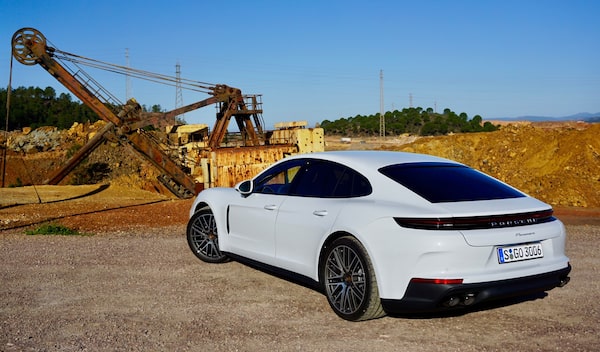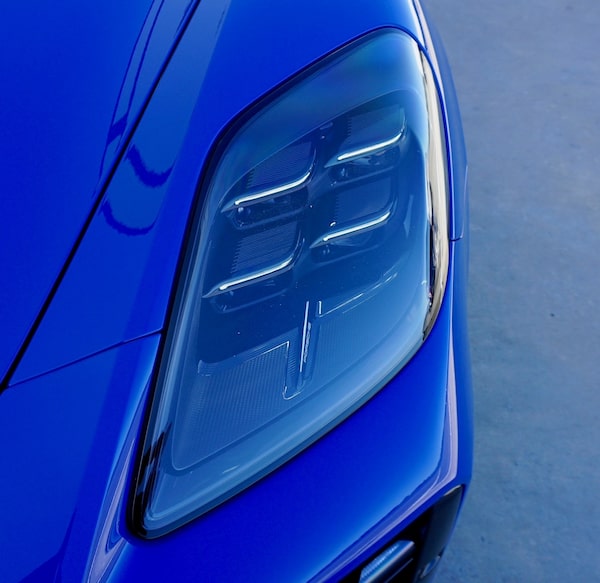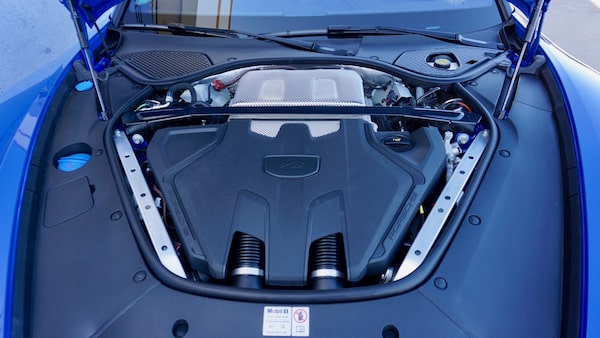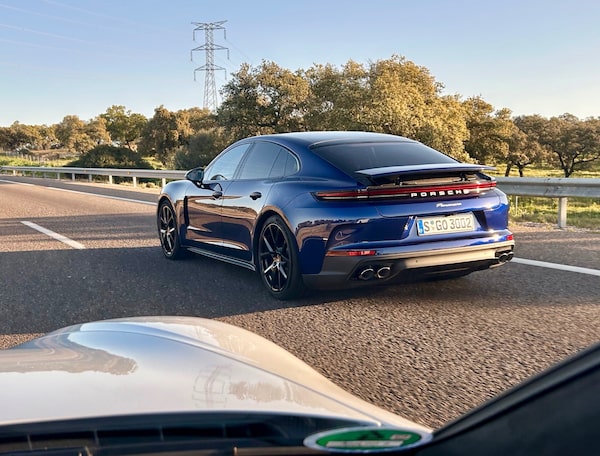
Jeremy Sinek/The Globe and Mail
When somebody says “we have really changed the world,” the optimist brain conjures up ideals like world peace and the end of poverty. Finally! But when the speaker is a senior engineer for Porsche, it’s safer just to assume he is extraordinarily proud of the new technology his employer is bringing to market.
The occasion is a first-drive program for the third-generation (G3) Porsche Panamera, and the technology is Active Ride, a form of active suspension that is debuting on the luxury sport “sedan” (it’s actually a liftback).
Does Active Ride work? Certainly. Is it a world-changing innovation that rewrites the laws of automotive physics? Let’s unpack that later. The optional suspension could justify a whole story just to itself, but that would overshadow much else that’s new on the 2024 Panamera and Panamera 4, which starts at more than $115,000, and the 2025 Turbo E-Hybrid we’re here in Spain to drive.
In Porsche tradition, the G3 variants are being revealed in stages. Mostly recently, Porsche unwrapped two V6-based E-Hybrids that produce 463 or 536-horsepower (all E-Hybrids are plug-ins), and we’re pretty sure a 700-plus-horsepower Turbo S E-Hybrid is in the works. For now, the 670-horsepower Turbo E-Hybrid (no “S”) sits atop the lineup.

A revised lighting bar and frameless tailgate window help distinguish the new design.Jeremy Sinek/The Globe and Mail

The four-element Matrix LED headlamps are new for the 2024 (Panamera) and 2025 (E-Hybrid) models.Jeremy Sinek/The Globe and Mail
The foundation of the G3 is an evolution of the MSB architecture that was all new on the 2017 G2, though the wagonoid Gran Turismo and long wheel base Executive are no more. Visible cues include, from the front, new four-bar HID headlamp elements, and from behind, a frameless liftgate window.
On base Panameras, the 2.9-litre V6 engine now makes 348 horsepower and 368 lb-ft of torque – gains of 23 and 37 respectively – while a revised two-chamber air-spring suspension with two-valve dampers is standard. A refreshed interior incorporates updated electronics that can be integrated into the driver’s “digital ecosystem,” as Porsche calls it.

The underhood view of the Turbo E-Hybrid provides little clue to the power and technology lurking below.Jeremy Sinek/The Globe and Mail
Perhaps the most valuable advances (think: carbon footprint) are on the Turbo E-Hybrid. This gets a larger 25.9-kilowatt-hour battery that, along with other enhancements, enables 75 per cent more electric range than the outgoing Turbo S E-Hybrid’s 17.9-kilowatt-hour battery. Figure on 45 to 50 kilometres.
Porsche also improved recuperation under deceleration, while an 11-kilowatt on-board AC charger can recharge the (larger) battery in less than three hours on a suitable Level 2 charger.
A 140-kilowatt electric motor (up from 100 on the old Turbo S) is now fully integrated into the housing of the revised eight-speed dual-clutch transmission, with electric operation the default on start-up. The four-litre V8, itself heavily revamped, fires up when needed, for combined system outputs up to 670 horsepower and 685 lb-ft of torque. When all that is fully deployed, the 0-100-kilometres-per-hour benchmark arrives 3.2 seconds after launch.

It’s no stretch limo or minivan, but by sports-car standards the rear cabin is comfortably habitable for adults and/or extra cargo.Jeremy Sinek/The Globe and Mail
We sampled a couple of maximum-effort departures during a brief street drive and our internal organs were suitably re-arranged while our gearhead ears savoured the intoxicating exhaust blat. Yet despite the lead-footery, and making no effort to maximize electric driving the rest of the time (we were more focussed on the Active Ride than on the powertrain) our 35-kilometre loop returned 10 litres per 100 kilometres.
Now, back to Active Ride. Porsche displayed spider charts showing how, even compared with previous adaptive suspensions, the active suspension dramatically expands the bandwidth between control and comfort – with most of the gains on the comfort axes. The suspension continuously softens or stiffens according to road conditions and driving style, while actively keeping the car level at all times.

The diminutive drive selector on the dashboard is user-friendly and saves space but seems rather effete in a high-performance car.Jeremy Sinek/The Globe and Mail

The optional front-passenger display screen cannot be seen from the driver’s side.Jeremy Sinek/The Globe and Mail

The curved digital gauge cluster looks great from the driver’s seat but looks a bit unfinished from this angle.Jeremy Sinek/The Globe and Mail

There is a reasonable balance between touch-sensitive and actual switchgear.Jeremy Sinek/The Globe and Mail
Most of our day was taken up with controlled demonstrations, including hot laps of a race track where the computerized technical wizardry mercifully didn’t diminish old-school seat-of-pants feel as we hustled to keep pace with the 911 Turbo lead car on the unfamiliar track.
We also experienced, and were convinced by, sudden-lane-change and panic-braking demonstrations in Panameras with and without Active Ride. And who could not be awe-struck by the “laboratory” demonstration of the suspension over an artificial surface of long-wave undulations? Watching from outside, the car body seemed to glide serenely above while the wheels faithfully followed the humps and dips. From inside, we felt some turbulence, but vastly less than you would expect.
Active Ride also includes a driver-selectable Active Comfort mode that counters G forces acting on the occupants by tilting the car body the opposite way to normal – leaning into turns like a motorcycle and lifting the nose under braking or the tail under acceleration. Let’s file that one under “Party Trick.” It only operates at low G forces and, at best, may benefit passengers with queasy stomachs.
Now, the elephant in the room. All the Panameras we drove were on optional 21-inch wheels wrapped in Michelin Pilot Sport S 5 rubber – a new summer tire strongly skewed to track driving. These tires were terrific on the track, but on patchwork-quilt Spanish backroads they broadcast the pavement’s textures and fissures so raucously that the comfort dividend from the Turbo E-Hybrid’s Active Ride was largely lost in the din. The same issue also detracted from the otherwise delightfully agile base Panameras in which we did most of our road driving.

Turbo models are now distinguished by light grey elements including this monochrome hood badgeJeremy Sinek/The Globe and Mail
Still, like any Porsche the Panamera can be whatever you want it to be, depending on your picks from the profusion of models and options. The base 2024 Panamera that we drove in Spain starts at $116,300 in Canada but had more than $37,000 worth of options.
No Canadian price yet on the 2025 Turbo E-Hybrid, but expect close to $200,000. Active Ride will be available on all E-Hybrid Panameras, and, if priced like on Taycan, would add another $8,150. That seems reasonable for such a marvel of technology - even if it doesn’t bring about world peace or an end to poverty.
Tech specs

2024 and 2025 Porsche Panamera.Jeremy Sinek/The Globe and Mail
2024 and 2025 Porsche Panamera
- Price: From $116,300 (plus freight, dealer fees, luxury tax and other fees and taxes)
- Engines: 2.9-litre twin-turbo V6 (Panamera/Panamera 4); Four-litre twin-turbo V8/140-kilowatt electric motor (Turbo E-Hybrid)
- Transmission/drive: Eight-speed dual-clutch automatic/RWD or AWD
- Fuel consumption: To be announced
- Alternatives: Audi RS7, BMW 8 Series Grand Coupe, Cadillac CT5-V Blackwing, Mercedes-AMG GT Coupe
The writer was a guest of the automaker. Content was not subject to approval.
Shopping for a new car? Check out the new Globe Drive Build and Price Tool to see the latest discounts, rebates and rates on new cars, trucks and SUVs. Click here to get your price.